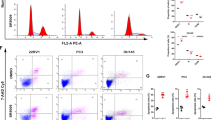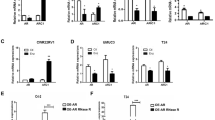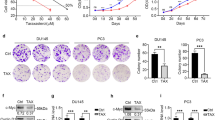Abstract
Background:
Non-steroidal anti-inflammatory drugs inhibit the activity of cyclooxygenases (COXs), and their usage reduces the risks associated with prostate cancer. Celecoxib is a selective COX-2 inhibitor and reported to prevent the progression of prostate cancer. However, the mechanisms involved remain unclear. In this study, we investigated the suppression of prostate cancer growth by celecoxib and elucidated the biological relevance of the inhibited pathway in prostate cancer cell lines.
Methods:
Western blotting, quantitative real-time PCR and cell proliferation assay were used to resolve the mechanism of celecoxib in prostate cancer cell line PC3, LNCaP and their derivatives.
Results:
Celecoxib induced apoptosis and downregulated EP2, CREB and androgen receptor (AR). Moreover, EP2 antagonist downregulated CREB as well as COX-2 and AR, resulting in the suppression of cell proliferation. Furthermore, EP2 and CREB knockdown induced AR downregulation, indicating that AR suppression by celecoxib is mediated by EP2/CREB signaling.
Conclusions:
Celecoxib exerts antitumor activity through EP2 signaling regulating AR and COX-2 expression. Furthermore, in addition to celecoxib, therapeutics targeting EP2 may also be promising against prostate cancers.
This is a preview of subscription content, access via your institution
Access options
Subscribe to this journal
Receive 4 print issues and online access
$259.00 per year
only $64.75 per issue
Buy this article
- Purchase on Springer Link
- Instant access to full article PDF
Prices may be subject to local taxes which are calculated during checkout








Similar content being viewed by others
References
Siegel R, Naishadham D, Jemal A . Cancer statistics, 2012. CA: Cancer J Clin 2012; 62: 10–29.
Wolff H, Saukkonen K, Anttila S, Karjalainen A, Vainio H, Ristimaki A . Expression of cyclooxygenase-2 in human lung carcinoma. Cancer Res 1998; 58: 4997–5001.
Eberhart CE, Coffey R, Radhika A, Giardiello F, Ferrenbach S, DuBois R . Up-regulation of cyclooxygenase 2 gene expression in human colorectal adenomas and adenocarcinomas. Gastroenterology 1994; 107: 1183–1188.
Hwang D, Byrne J, Scollard D, Levine E . Expression of cyclooxygenase-1 and cyclooxygenase-2 in human breast cancer. J Natl Cancer Inst 1998; 90: 455–460.
Gupta S, Srivastava M, Ahmad N, Bostwick DG, Mukhtar H . Overexpression of cyclooxygenase 2 in human prostate adenocarcinoma. Prostate 2000; 42: 73–78.
Brown JR, DuBois RN . Cyclooxygenase as a target in lung cancer. Clin Cancer Res 2004; 10: 4266–4269.
Brown JR, DuBois RN . COX-2: a molecular target for colorectal cancer prevention. J Clin Oncol 2005; 23: 2840–2855.
Masferrer JL, Leahy KM, Koki AT, Zweifel BS, Settle SL, Woerner BM et al. Antiangiogenic and antitumor activities of cyclooxygenase-2 inhibitors. Cancer Res 2000; 60: 1306–1311.
Iwata C, Kano MR, Komuro A, Oka M, Kiyono K, Johansson E et al. Inhibition of cyclooxygenase-2 suppresses lymph node metastasis via reduction of lymphangiogenesis. Cancer Res 2007; 67: 10181–10189.
O'Byrne K, Dalgleish A . Chronic immune activation and inflammation as the cause of malignancy. Br J Cancer 2001; 85: 473–483.
Funk CD . Prostaglandins and leukotrienes: advances in eicosanoid biology. Science 2001; 294: 1871–1875.
Wang X, Klein RD . Prostaglandin E2 induces vascular endothelial growth factor secretion in prostate cancer cells through EP2 receptor-mediated cAMP pathway. Mol Carcinog 2007; 46: 912–923.
Jain S, Chakraborty G, Raja R, Kale S, Kundu GC . Prostaglandin E2 regulates tumor angiogenesis in prostate cancer. Cancer Res 2008; 68: 7750–7759.
Fulton AM, Ma X, Kundu N . Targeting prostaglandin E EP receptors to inhibit metastasis. Cancer Res 2006; 66: 9794–9797.
Roberts RO, Jacobson DJ, Girman CJ, Rhodes T, Lieber MM, Jacobsen SJ . A population-based study of daily nonsteroidal anti-inflammatory drug use and prostate cancer. Mayo Clin Proc 2002; 77: 219–225.
Nelson J, Harris R . Inverse association of prostate cancer and non-steroidal anti-inflammatory drugs (NSAIDs): results of a case-control study. Oncol Rep 2000; 7: 169–170.
Choe KS, Cowan JE, Chan JM, Carroll PR, D'Amico AV, Liauw SL . Aspirin use and the risk of prostate cancer mortality in men treated with prostatectomy or radiotherapy. J Clin Oncol 2012; 30: 3540–3544.
Hsu AL, Ching TT, Wang DS, Song X, Rangnekar VM, Chen CS . The cyclooxygenase-2 inhibitor celecoxib induces apoptosis by blocking Akt activation in human prostate cancer cells independently of Bcl-2. J Biol Chem 2000; 275: 11397–11403.
Lim JTE, Piazza GA, Han EKH, Delohery TM, Li H, Finn TS et al. Sulindac derivatives inhibit growth and induce apoptosis in human prostate cancer cell lines. Biochem Pharmacol 1999; 58: 1097–1107.
Lim JTE, Piazza GA, Pamukcu R, Thompson WJ, Weinstein IB . Exisulind and related compounds inhibit expression and function of the androgen receptor in human prostate cancer cells. Clin Cancer Res 2003; 9: 4972–4982.
Pan Y, Zhang JS, Gazi MH, Young CYF . The cyclooxygenase 2-specific nonsteroidal anti-inflammatory drugs celecoxib and nimesulide inhibit androgen receptor activity via induction of c-Jun in prostate cancer cells. Cancer Epidemiol Biomarkers Prev 2003; 12: 769–774.
Chang SH, Liu CH, Conway R, Han DK, Nithipatikom K, Trifan OC et al. Role of prostaglandin E2-dependent angiogenic switch in cyclooxygenase 2-induced breast cancer progression. Proc Natl Acad Sci USA 2004; 101: 591–596.
Hussain T, Gupta S, Mukhtar H . Cyclooxygenase-2 and prostate carcinogenesis. Cancer Lett 2003; 191: 125–135.
Shiota M, Yokomizo A, Tada Y, Inokuchi J, Kashiwagi E, Masubuchi D et al. Castration resistance of prostate cancer cells caused by castration-induced oxidative stress through Twist1 and androgen receptor overexpression. Oncogene 2010; 29: 237–250.
Kashiwagi E, Izumi H, Yasuniwa Y, Baba R, Doi Y, Kidani A et al. Enhanced expression of nuclear factor I/B in oxaliplatin‐resistant human cancer cell lines. Cancer Sci 2010; 102: 382–386.
Shiota M, Izumi H, Onitsuka T, Miyamoto N, Kashiwagi E, Kidani A et al. Twist promotes tumor cell growth through YB-1 expression. Cancer Res 2008; 68: 98–105.
Shiota M, Izumi H, Tanimoto A, Takahashi M, Miyamoto N, Kashiwagi E et al. Programmed cell death protein 4 down-regulates Y-box binding protein-1 expression via a direct interaction with Twist1 to suppress cancer cell growth. Cancer Res 2009; 69: 3148–3156.
Kashiwagi E, Shiota M, Yokomizo A, Itsumi M, Inokuchi J, Uchiumi T et al. Downregulation of phosphodiesterase 4B (PDE4B) activates protein kinase A and contributes to the progression of prostate cancer. Prostate 2011; 72: 741–751.
Shiota M, Yokomizo A, Naito S . Increased androgen receptor transcription: a cause of castration-resistant prostate cancer and a possible therapeutic target. J Mol Endocrinol 2011; 47: 25–41.
Eliopoulos AG, Dumitru CD, Wang CC, Cho J, Tsichlis PN . Induction of COX-2 by LPS in macrophages is regulated by Tpl2-dependent CREB activation signals. EMBO J 2002; 21: 4831–4840.
Fujino H, Salvi S, Regan JW . Differential regulation of phosphorylation of the cAMP response element-binding protein after activation of EP2 and EP4 prostanoid receptors by prostaglandin E2. Mol Pharmacol 2005; 68: 251–259.
Rundhaug J, Simper M, Surh I, Fischer S . The role of the EP receptors for prostaglandin E 2 in skin and skin cancer. Cancer Metastasis Rev 2011; 30: 465–480.
Mizokami A, Yeh SY, Chang C . Identification of 3', 5'-cyclic adenosine monophosphate response element and other cis-acting elements in the human androgen receptor gene promoter. Mol Endocrinol 1994; 8: 77–88.
Song S, Guha S, Liu K, Buttar NS, Bresalier RS . COX-2 induction by unconjugated bile acids involves reactive oxygen species-mediated signalling pathways in Barrett's oesophagus and oesophageal adenocarcinoma. Gut 2007; 56: 1512–1521.
Kim J, Jia L, Stallcup M, Coetzee G . The role of protein kinase A pathway and cAMP responsive element-binding protein in androgen receptor-mediated transcription at the prostate-specific antigen locus. J Mol Endocrinol 2005; 34: 107–118.
Ansari KM, Sung YM, He G, Fischer SM . Prostaglandin receptor EP2 is responsible for cyclooxygenase-2 induction by prostaglandin E2 in mouse skin. Carcinogenesis 2007; 28: 2063–2068.
Kashiwagi E, Shiota M, Yokomizo A, Inokuchi J, Itsumi M, Uchiumi T et al. Prostaglandin receptor EP3 mediates growth inhibitory effect of aspirin through androgen receptor and contributes to castration resistance in prostate cancer cells. Endocr Relat Cancer 2013; 20: 431–441.
Katkoori V, Manne K, Vital-Reyes V, Rodríguez-Burford C, Shanmugam C, Sthanam M et al. Selective COX-2 inhibitor (celecoxib) decreases cellular growth in prostate cancer cell lines independent of p53. Biotech Histochem 2013; 88: 38–46.
Patel M, Subbaramaiah K, Du B, Chang M, Yang P, Newman R et al. Celecoxib inhibits prostate cancer growth: evidence of a cyclooxygenase-2-independent mechanism. Clin Cancer Res 2005; 11: 1999–2007.
James ND, Sydes MR, Mason MD, Clarke NW, Anderson J, Dearnaley DP et al. Celecoxib plus hormone therapy versus hormone therapy alone for hormone-sensitive prostate cancer: first results from the STAMPEDE multiarm, multistage, randomised controlled trial. Lancet Oncol 2012; 13: 549–558.
Sung YM, He G, Fischer SM . Lack of expression of the EP2 but not EP3 receptor for prostaglandin E2 results in suppression of skin tumor development. Cancer Res 2005; 65: 9304–9311.
Subbaramaiah K, Hudis C, Chang SH, Hla T, Dannenberg AJ . EP2 and EP4 receptors regulate aromatase expression in human adipocytes and breast cancer cells. J Biol Chem 2008; 283: 3433–3444.
Shin VY, Jin HC, Ng EKO, Cho CH, Leung WK, Sung JJY et al. 4-(Methylnitrosamino)-1-(3-pyridyl)-1-butanone promoted gastric cancer growth through prostaglandin E receptor (EP2 and EP4) in vivo and in vitro. Cancer Sci 2011; 102: 926–933.
Tian M, Schiemann WP . PGE2 receptor EP2 mediates the antagonistic effect of COX-2 on TGF-beta signaling during mammary tumorigenesis. FASEB J 2010; 24: 1105–1116.
Miyata Y, Kanda S, Maruta S, Matsuo T, Sakai H, Hayashi T et al. Relationship between prostaglandin E< sub> 2</sub> receptors and clinicopathologic features in human prostate cancer tissue. Urology 2006; 68: 1360–1365.
Solomon SD, McMurray JJV, Pfeffer MA, Wittes J, Fowler R, Finn P et al. Cardiovascular risk associated with celecoxib in a clinical trial for colorectal adenoma prevention. N Engl J Med 2005; 352: 1071–1080.
Acknowledgements
We thank Dr Dongchon Kang (Kyushu University, Fukuoka, Japan) for helping with the quantitative real-time PCR experiments, and Noriko Hakoda and Eriko Gunshima for their technical assistance.
Author information
Authors and Affiliations
Corresponding author
Ethics declarations
Competing interests
The authors declare no conflict of interest.
Additional information
Supplementary Information accompanies the paper on the Prostate Cancer and Prostatic Diseases website
Supplementary information
Rights and permissions
About this article
Cite this article
Kashiwagi, E., Shiota, M., Yokomizo, A. et al. EP2 signaling mediates suppressive effects of celecoxib on androgen receptor expression and cell proliferation in prostate cancer. Prostate Cancer Prostatic Dis 17, 10–17 (2014). https://doi.org/10.1038/pcan.2013.53
Received:
Revised:
Accepted:
Published:
Issue Date:
DOI: https://doi.org/10.1038/pcan.2013.53
Keywords
This article is cited by
-
Grouping of chemicals into mode of action classes by automated effect pattern analysis using the zebrafish embryo toxicity test
Archives of Toxicology (2022)
-
Prostaglandin receptors induce urothelial tumourigenesis as well as bladder cancer progression and cisplatin resistance presumably via modulating PTEN expression
British Journal of Cancer (2018)
-
COX-2 mediates pro-tumorigenic effects of PKCε in prostate cancer
Oncogene (2018)
-
Role of 20-Hydroxyeicosatetraenoic Acid (20-HETE) in Androgen-Mediated Cell Viability in Prostate Cancer Cells
Hormones and Cancer (2017)
-
Intracellular EP2 prostanoid receptor promotes cancer-related phenotypes in PC3 cells
Cellular and Molecular Life Sciences (2015)



